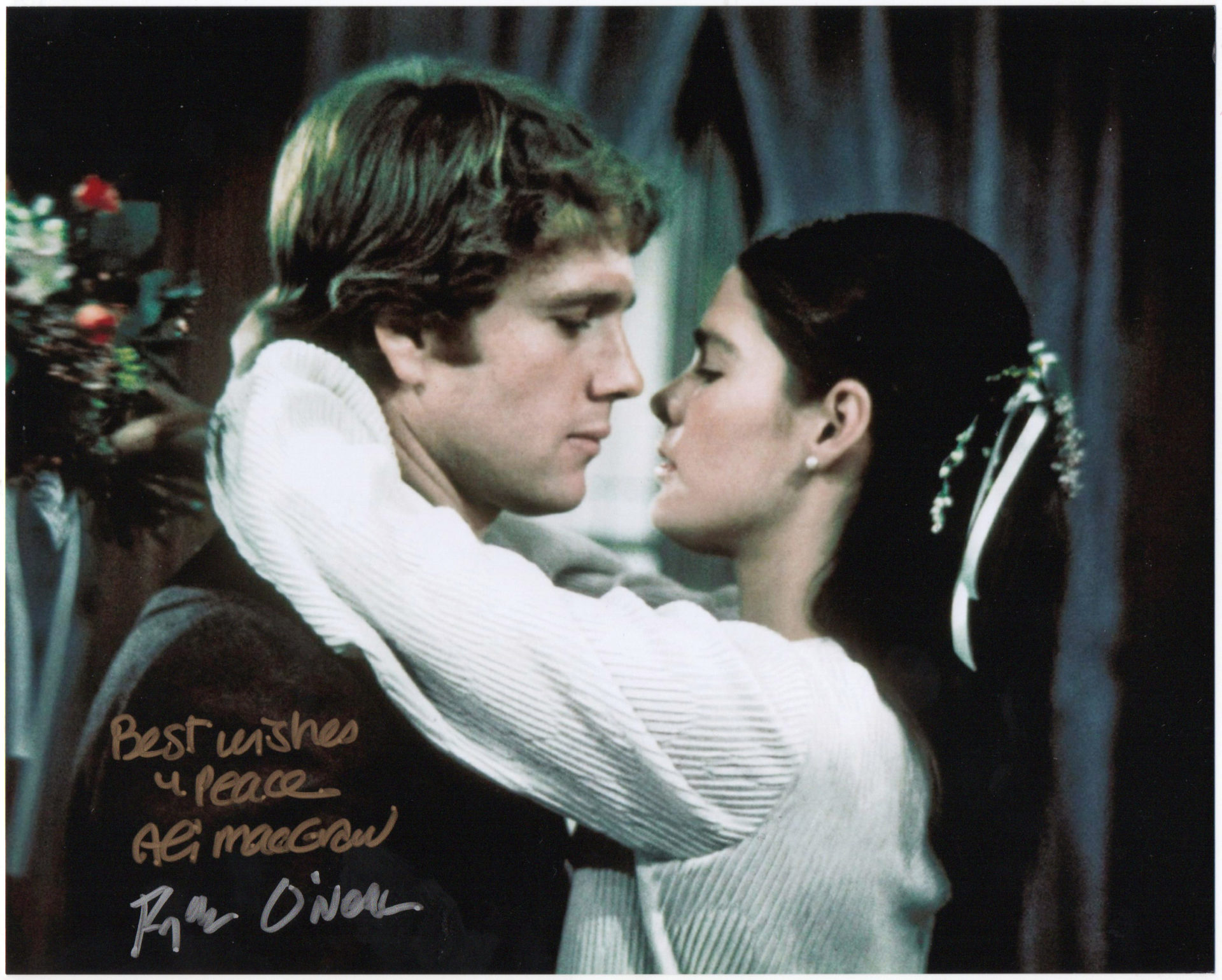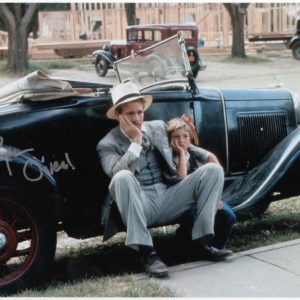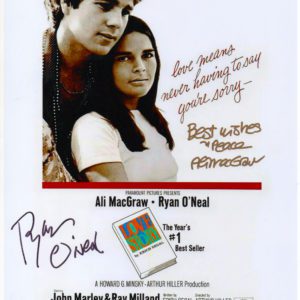Description
RYAN O’NEAL BIOGRAPHY :
Ryan O’Neal (April 20, 1941 – December 8, 2023) was an American actor. Born in Los Angeles, he trained as an amateur boxer before beginning a career in acting in 1960. In 1964, he landed the role of Rodney Harrington on the ABC nighttime soap opera Peyton Place. It was an instant hit and boosted O’Neal’s career. He later found success in films, most notably in the romantic drama Love Story (1970), for which he was nominated for the Academy Award for Best Actor and the Golden Globe Award for Best Actor – Motion Picture Drama; Peter Bogdanovich’s What’s Up, Doc? (1972); Paper Moon (1973), which earned him a nomination for the Golden Globe Award for Best Actor – Motion Picture Musical or Comedy; Stanley Kubrick’s Barry Lyndon (1975), in which he portrayed the titular character; Richard Attenborough’s A Bridge Too Far (1977); and Walter Hill’s The Driver (1978). From 2005 to 2017, he had a recurring role in the Fox television series Bones as Max, the father of the show’s eponymous protagonist.
ALI MACGRAW BIOGRAPHY :
Elizabeth Alice MacGraw (born April 1, 1939) is an American actress and activist. She gained attention with her role in the film Goodbye, Columbus (1969), for which she won the Golden Globe Award for Most Promising Newcomer. She gained an international profile for her role in the film Love Story (1970), for which she was nominated for an Academy Award for Best Actress and won the Golden Globe Award for Best Actress in a Motion Picture – Drama. In 1972, MacGraw was voted the top female box office star in the world and was honored with a hands and footprints ceremony at Grauman’s Chinese Theatre after having been in just three films. She went on to star in the popular action films The Getaway (1972). Despite her momentum, she took a six year break from acting just as her career was skyrocketing. She would play the female lead in Convoy (1978) and headline the romantic sports drama Players (1979), the comedy Just Tell Me What You Want (1980), and appear in the historical novel-based television miniseries The Winds of War (1983). In 1991, she published an autobiography, Moving Pictures.
Career
Early career
Beginning in 1960, MacGraw spent six years working at Harper’s Bazaar magazine as a photographic assistant to fashion maven Diana Vreeland. She worked at Vogue magazine as a fashion model, and as a photographer’s stylist. She has also worked as an interior decorator.
Film and television
MacGraw began her acting career in television commercials, including one for the Polaroid Swinger camera. In one commercial for International Paper, she was on a beach in a bikini made of Confil and went for a swim underwater to prove its strength and durability. MacGraw gained attention in the film Goodbye, Columbus (1969), but real stardom came when she starred opposite Ryan O’Neal in Love Story (1970), one of the highest-grossing films in U.S. history. MacGraw was nominated for the Academy Award for Best Actress for that performance. Following Love Story, MacGraw was celebrated on the cover of Time magazine. In 1972, after appearing in just three films, she had her footprints and autograph engraved at Grauman’s Chinese Theatre. She then starred opposite Steve McQueen in The Getaway (1972), which was one of the year’s top ten films at the box office. Having taken a five-year break from acting, in 1978 MacGraw re-emerged in another box office hit, Convoy (1978), opposite Kris Kristofferson. She then appeared in the films Players (1979) and Just Tell Me What You Want (1980), directed by Sidney Lumet. In 1983, MacGraw starred in the highly successful television miniseries The Winds of War. In 1985, MacGraw joined hit ABC prime-time soap opera Dynasty as Lady Ashley Mitchell, which, she admitted in a 2011 interview, she did for the money. She appeared in 14 episodes of the show before her character was killed off in the “Moldavian Massacre” cliffhanger episode in 1985. In February 2021, MacGraw and O’Neal were honored with stars on the Hollywood Walk of Fame, nearly 50 years after the release of Love Story.
Stage
MacGraw made her Broadway theatre debut in New York City in 2006 as a dysfunctional matriarch in the drama Festen (The Celebration). In 2016, MacGraw reunited with Ryan O’Neal in a staging of A.R. Gurney’s play Love Letters, which toured the US and UK through 2017.
Magazine recognition
In 1991, People magazine selected MacGraw as one of its “50 Most Beautiful People” in the World. In 2008 GQ magazine listed her in their “Sexiest 25 Women in Film Ever” edition.
Yoga
Having become a Hatha Yoga devotee in her early 50s, MacGraw produced a yoga video with the American Yoga Master Erich Schiffmann, Ali MacGraw Yoga Mind and Body. The impact of this bestselling video was such that in June 2007 Vanity Fair magazine credited MacGraw with being one of the people responsible for the practice’s recent popularity in the United States.
Early career
Beginning in 1960, MacGraw spent six years working at Harper’s Bazaar magazine as a photographic assistant to fashion maven Diana Vreeland. She worked at Vogue magazine as a fashion model, and as a photographer’s stylist. She has also worked as an interior decorator.
Film and television
MacGraw began her acting career in television commercials, including one for the Polaroid Swinger camera. In one commercial for International Paper, she was on a beach in a bikini made of Confil and went for a swim underwater to prove its strength and durability. MacGraw gained attention in the film Goodbye, Columbus (1969), but real stardom came when she starred opposite Ryan O’Neal in Love Story (1970), one of the highest-grossing films in U.S. history. MacGraw was nominated for the Academy Award for Best Actress for that performance. Following Love Story, MacGraw was celebrated on the cover of Time magazine. In 1972, after appearing in just three films, she had her footprints and autograph engraved at Grauman’s Chinese Theatre. She then starred opposite Steve McQueen in The Getaway (1972), which was one of the year’s top ten films at the box office. Having taken a five-year break from acting, in 1978 MacGraw re-emerged in another box office hit, Convoy (1978), opposite Kris Kristofferson. She then appeared in the films Players (1979) and Just Tell Me What You Want (1980), directed by Sidney Lumet. In 1983, MacGraw starred in the highly successful television miniseries The Winds of War. In 1985, MacGraw joined hit ABC prime-time soap opera Dynasty as Lady Ashley Mitchell, which, she admitted in a 2011 interview, she did for the money. She appeared in 14 episodes of the show before her character was killed off in the “Moldavian Massacre” cliffhanger episode in 1985. In February 2021, MacGraw and O’Neal were honored with stars on the Hollywood Walk of Fame, nearly 50 years after the release of Love Story.
Stage
MacGraw made her Broadway theatre debut in New York City in 2006 as a dysfunctional matriarch in the drama Festen (The Celebration). In 2016, MacGraw reunited with Ryan O’Neal in a staging of A.R. Gurney’s play Love Letters, which toured the US and UK through 2017.
Magazine recognition
In 1991, People magazine selected MacGraw as one of its “50 Most Beautiful People” in the World. In 2008 GQ magazine listed her in their “Sexiest 25 Women in Film Ever” edition.
Yoga
Having become a Hatha Yoga devotee in her early 50s, MacGraw produced a yoga video with the American Yoga Master Erich Schiffmann, Ali MacGraw Yoga Mind and Body. The impact of this bestselling video was such that in June 2007 Vanity Fair magazine credited MacGraw with being one of the people responsible for the practice’s recent popularity in the United States.




